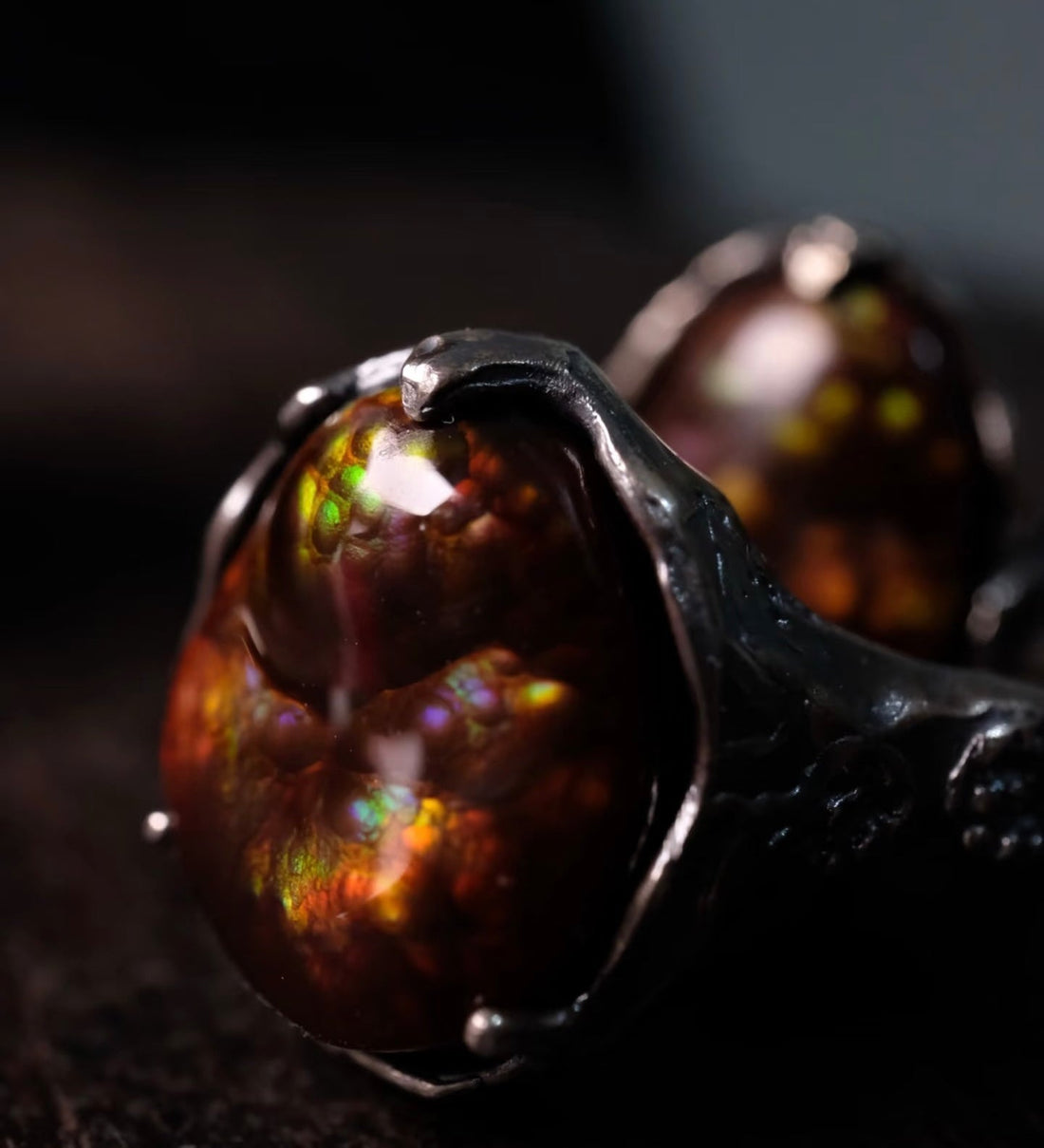
Fire Agate: A Guide to North America’s Hidden Gemstone Treasure
Share
Hey everyone! If you're into unique crystals, gemstones, or minerals, you need to know about Fire Agate.
This isn’t your average gemstone—it’s like holding a miniature volcano in your hand. Some of the best-quality Fire Agate even comes from the Southwestern United States.
This guide will cover everything: what Fire Agate is, its meaning, how to spot fakes, and what to expect price-wise.
What Exactly Is Fire Agate?
At its core, Fire Agate is a variety of chalcedony, a microcrystalline form of quartz (SiO₂). That puts it in the same family as agate and jasper. But what sets Fire Agate apart is its mind-blowing fiery light show.
This “fire” isn’t just a color—it’s an optical phenomenon called the Schiller Effect (or Iridescence).
Here’s the science in simple terms:
- Layered Structure: Fire Agate formed through layers of silica gel deposited over time. Thin films of iron oxide (like limonite) settled between these layers.
- Light Interference: Light passes through the silica layers, reflects off the iron oxide films, and the waves interfere, amplifying certain colors.
- The Result: Flashes of red, orange, gold, green, and blue appear beneath the surface. The fire moves and shifts as the stone tilts.
Without this effect, Fire Agate would look like a dark-brown stone. Its beauty is entirely dynamic.
Fire Agate’s Meaning and Connection to “Fire Energy”
In crystal healing and metaphysics, Fire Agate is considered a stone of protection, courage, and vitality. Many believe it can ignite passion, overcome inertia, and provide grounding energy during change.
Some connect Fire Agate to the “Age of Fire” in Feng Shui and Chinese metaphysics. From 2024 to 2043, Fire energy dominates, symbolizing innovation, technology, beauty, and spiritual growth. While unrelated geologically, Fire Agate’s fiery energy makes it a powerful talisman for this transformative era.
How to Identify Genuine Fire Agate (and Spot Fakes)
The gemstone market is full of imitations—dyed agate, coated agate, or iridescent glass. Here’s how to tell real Fire Agate from a fake.
Key Characteristics of Real Fire Agate
- Internal and Alive Fire: Colors glow from within. Flashes move and change as you rotate the stone, like burning embers.
- Distinct Flashes: Fire appears in scattered scales or patches, each with clear boundaries.
- Natural Base Color: Usually deep brown, chocolate, purple, or green, often with an earthy texture.
Red Flags for Fake Fire Agate
- Surface Oil-Slick Color: Rainbow looks like a thin film on the surface, shifting uniformly without depth.
- Too Perfect or Uniform: Iridescence appears bubble-like, with no distinct patches.
- Unnatural Base: Plastic- or glass-like appearance, or colors not found in natural agates.
Pro Tips for Buying Fire Agate
- Always Ask for a Video: Sellers should provide a slow rotation video in natural light.
- Use a Loupe: Under 10× magnification, genuine Fire Agate shows layered structure. Coated fakes may show fine cracks.
- Buy from Reputable Sellers: Choose established dealers with positive reviews.
- Request Certification: For expensive pieces, ask for a certificate from labs such as GIA or AGS.
Understanding Fire Agate Price and Value
Unlike diamonds, Fire Agate is not priced strictly by carat weight. Value depends on the quality and intensity of the fire.
Factors That Dictate Value
-
Quality of Fire (Most Important):
- High-End: Bright fire covering most of the surface with strong reds and oranges. $150–$500+ per carat.
- Mid-Range: Attractive but less intense fire, or smaller coverage. $50–$150 per carat.
- Low-End: Weak or small fire patches. Under $50 per carat, often sold as rough.
- Cutting and Craftsmanship: Skilled cutting maximizes fire, greatly increasing value.
- Base Color and Clarity: Clean, attractive bases (deep purple, chocolate brown) contrast well with fire. Cracks reduce value.
- Size and Origin: Large stones with strong fire are rare. Arizona Fire Agate is especially prized and commands higher prices.
Typical Price Ranges
- Rough Specimens (Uncut): $10–$500+ depending on fire potential.
- Cabochons (Cut & Polished): From $50 for small stones to thousands for top-quality.
- Finished Jewelry: $100–$500 for silver pendants; $2,000–$10,000+ for gold rings with collector-grade stones.
Fire Agate is a one-of-a-kind gemstone—a natural combination of earthy grounding and fiery brilliance. Whether valued for its beauty, metaphysical properties, or geological wonder, Fire Agate always sparks conversation.
Explore the world of Fire Agate, and remember: the best stone is always the one whose fire speaks to you.
💡 If you’re interested in connecting with Fire energy beyond gemstones, check out the Elemental Crystal Bonsai – Fire, a handcrafted piece that symbolizes balance and transformation through crystal energy.

